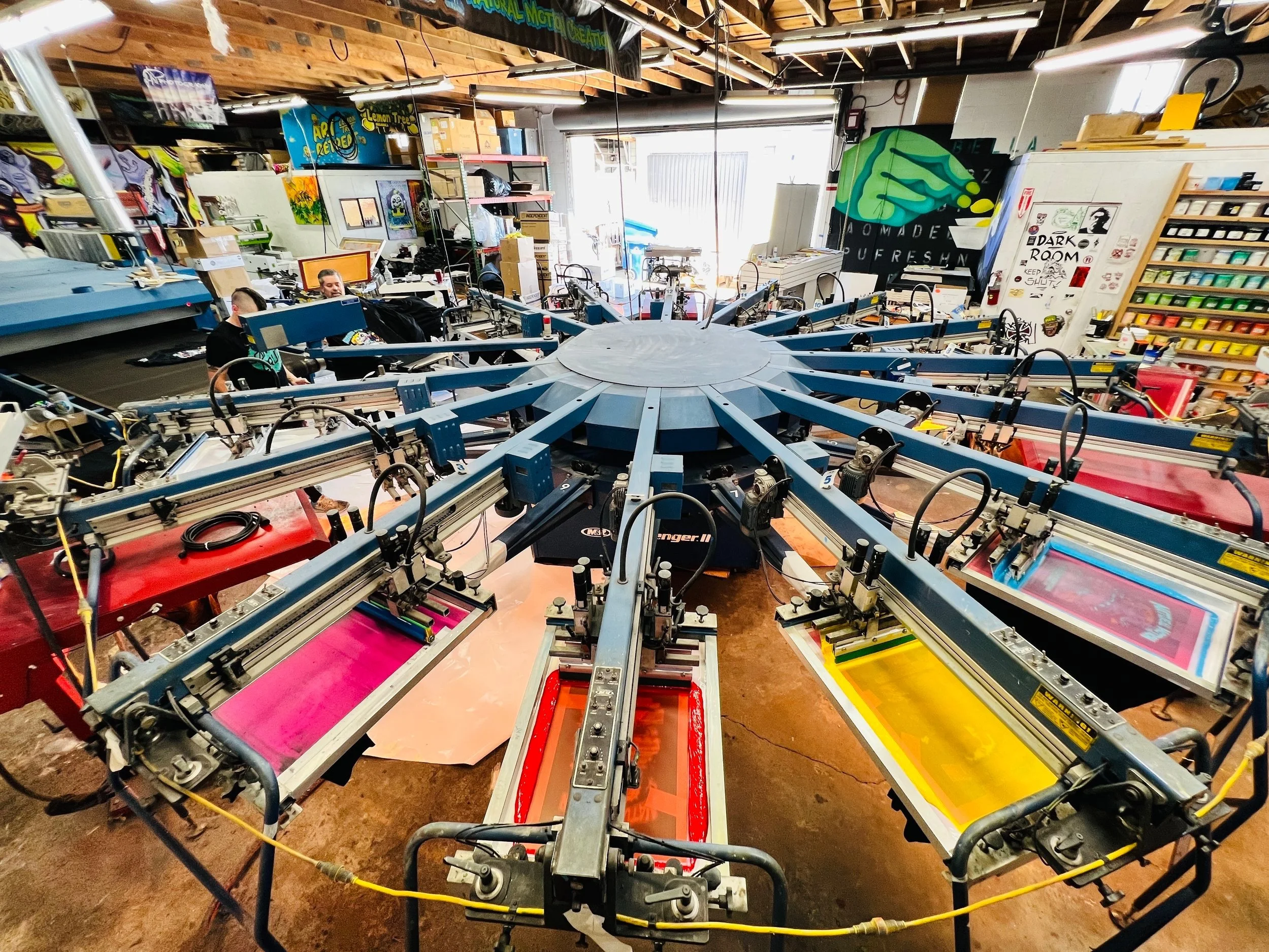Display Printing Uncovered: Every Little Thing You Need to Learn About T-Shirt and Garment Printing Techniques
Screen printing is an interesting approach that combines art with technique, supplying endless opportunities for imagination. Ready to check out the vital components that make display publishing an art form?
The Fundamentals of Display Printing: How It Works
When you plunge right into screen printing, you'll discover it's both a science and an art. At its core, screen printing entails creating a stencil, or display, that enables ink to pass via just in specific areas.
Following, you'll blend your inks and prepare your printing surface. Setting the display over the textile, after that use a squeegee to press ink via the display onto the garment. This procedure calls for precision, as you want clear, vivid prints. After printing, you'll heal the ink with heat, ensuring it sticks to the textile and lasts through washes. Each step is crucial, and understanding them will elevate your display printing abilities, transforming straightforward garments right into unique, expressive pieces.
Kinds Of Display Printing Strategies
Once you comprehend the basics of display printing, it's time to check out the different strategies that can elevate your designs. One prominent approach is standard display printing, where ink is pushed via a stenciled display. This strategy is terrific for strong, vivid colors. There's water-based ink printing, which supplies a softer feel and is environmentally friendly, but it needs a different strategy to curing.
An additional option is plastisol printing, understood for its resilience and brilliant shades, making it a favored for many brands. Experiment with halftone printing to develop gradient effects and complex designs.
Crucial Equipment for Display Printing
To achieve spectacular lead to display printing, having the ideal tools is basic. You'll need a strong display printing frame, which holds the mesh that transfers your layout onto the garment. Next, invest in high-grade squeegees; these are essential for using ink evenly across the screen. You'll likewise call for an excellent exposure system to produce your displays, as well as a washout booth for cleaning them after use. A reliable heat source, like a conveyor dryer or warm press, is critical for healing your prints to guarantee durability. Don't fail to remember a proper work space, geared up with tables and storage for your products. Safety gear, such as masks and gloves, will certainly keep you risk-free from chemicals and inks. With the right tools, you'll be well on your method to creating professional-quality prints.
Picking the Right Inks and Products
When choosing inks and products for display printing, you require to consider the kind of ink that works best for your project. Think of fabric compatibility to assure your designs look last and excellent long. Additionally, explore eco-friendly ink options to make your printing process more lasting.
Kinds Of Display Inks
Selecting the best screen ink is vital for accomplishing vibrant, resilient prints that satisfy your task's demands. There are a number of kinds of display inks to take a look at. Plastisol ink is preferred for its adaptability and convenience of use, giving superb color opacity on dark fabrics. Water-based ink, on the other hand, supplies a softer feeling and is environmentally friendly, making it excellent for those seeking to decrease their ecological impact. Discharge inks eliminate dye from the textile, resulting in a soft, vintage look yet require particular handling. Specialized inks, such as glow-in-the-dark or metal, can add special impacts to your designs. Evaluate your task requirements and choose the ink that lines up finest with your wanted outcome.

Textile Compatibility Factors To Consider
Recognizing fabric compatibility is crucial for accomplishing top notch display prints, especially considering that different materials react uniquely to various inks. Constantly test your inks on example material to assure they adhere correctly and maintain color honesty. In addition, maintain in mind that fabric weight and structure can affect the final result, so choosing the ideal ink and product combination is important for your task's success.
Eco-Friendly Ink Options
Green inks are ending up being a preferred option for display printers that desire to minimize their environmental impact while preserving top quality. When picking inks, think about water-based inks, which are much less harmful and less complicated to clean up contrasted to typical solvents.
Furthermore, seek inks made from sustainable sources, such as soy or vegetable-based alternatives. By picking the appropriate inks and materials, you'll not only develop magnificent styles but also add to an extra lasting printing procedure. Make the switch, and your prints will certainly show your commitment to the setting!
Preparing Your Design for Display Printing

Submit Style Needs
To guarantee your design looks vibrant and sharp on textile, you'll need to pay close attention to submit style needs for display printing. Make certain your style has a clear history to avoid undesirable white sides on your prints. Keep shade settings in mind; CMYK is basic for display printing, so transform your RGB makes as necessary.
Color Splitting Up Methods
Shade separation is an essential action in preparing your design for screen printing, and understanding it can considerably improve your print top quality. You'll require to break your layout right into private colors, as each shade needs a separate display during printing. Begin by determining all the colors in your style and develop layers each. You can utilize software like Adobe Photoshop or Illustrator to isolate and different shades efficiently. Be specific to conserve each layer as a different file, typically in a layout like TIFF or PSD. This accuracy not only ensures accurate color representation yet also simplifies the printing procedure. By paying interest to color separation, you'll accomplish expert and lively results in your screen-printed garments.
Resolution and Size
Attaining the finest lead to display printing begins with assuring your layout has the best resolution and dimension. Preferably, your art work should be at the very least 300 DPI (dots per inch) for sharp, clear prints. If you use reduced resolution, your final item could look pixelated and less than professional.
When it comes to size, think about the dimensions of your print location. Style your artwork to match the last print dimension, preferably creating it in the actual dimensions you'll be publishing. By doing this, you'll stay clear of any type of unforeseen scaling concerns.
Constantly check your layout in both vector and raster styles. Vector graphics can be scaled without shedding quality, making them optimal for display printing. Preparing properly will ensure your design looks outstanding on every garment!
Step-by-Step Display Printing Process
Screen printing is a dynamic process that allows you to develop vibrant styles on various surfaces. To begin, you'll need a display, solution, and your selected ink. First, prepare your display by cleaning it completely. Next off, apply the emulsion uniformly and let it completely dry in a dark area. Once completely dry, subject your screen to light with your style positioned on it, which will solidify the emulsion where the light hits, producing a pattern - screen printing kit.
After cleaning out the unexposed solution, your display is prepared. Set it up on your printing surface area and straighten your garment below it. Put ink onto the screen and make use of a squeegee to push the ink via the pattern onto the textile. Raise the display thoroughly and allow the print completely dry. Cure the ink using warm to guarantee toughness. That's it! You have actually successfully display published your design.
Tips for Effective Screen Printing Projects
While you're diving into your screen printing tasks, bear in mind that prep work is essential to success. Begin by gathering all your products-- inks, screens, garments, and squeegees. A tidy work area aids protect against undesirable mistakes, so tidy up prior to you start.
Next, confirm your artwork is high-resolution and correctly sized for your garment. Test your display for appropriate direct exposure and clean it extensively to prevent smudges. When mixing your inks, comply with the producer's standards to accomplish the best uniformity.
During printing, use also pressure with your squeegee for regular outcomes. Don't hurry; take your time to confirm each print meets your requirements. After printing, allow your garments completely dry totally prior to handling or packaging them.
Last but not least, constantly maintain a sample of your help future reference. By doing this, you can analyze your progress and improve your techniques with time. Satisfied printing!

Regularly Asked Questions
How much time Does It Take to Set up a Display Printing Task?
Establishing a screen printing task commonly takes about half an hour to an hour. You'll prepare the displays, mix inks, and readjust journalism. The moment differs based upon intricacy and experience, so remain arranged!
Can I Publish on Various Textile Types Making Use Of the Same Method?
Yes, you can publish on various fabric types making use of the same method, but you'll require to adjust your settings and inks. Some textiles take in ink differently, so trying out assurances the ideal results custom screen printing for every product.
What Are Common Mistakes to Stay Clear Of in Screen Printing?
When screen printing, stay clear of typical errors like making use of the wrong ink, overlooking correct exposure times, or missing pre-press checks. Always examine your setup and keep tidy screens to guarantee top quality results each time.
Exactly How Can I Effectively Clean and Maintain My Screen Printing Devices?
To effectively clean and maintain your display printing tools, you must on a regular basis clean displays with appropriate solvents, check squeegees for wear, and ensure all tools are saved dust-free and dry. Uniformity protects against costly repair work and improves performance.
Is Screen Printing Eco Friendly Compared to Other Techniques?
Screen printing can be a lot more ecologically pleasant than various other techniques, specifically if you make use of water-based inks and eco-conscious materials. By choosing sustainable supplies and practices, you reduce waste and decrease your impact on the planet.
Display Printing Uncovered: Every Little Thing You Required to Know About T-Shirt and Garment Printing Techniques
At its core, screen printing involves developing a pattern, or display, that permits ink to pass via only in details locations. Position the display over the textile, after that utilize a squeegee to push ink via the display onto the garment. One prominent method is traditional display printing, where ink is pressed via a stenciled display.When choosing inks and products for display printing, you require to take into account the type of ink that functions finest for your project.
 Alisan Porter Then & Now!
Alisan Porter Then & Now! Matilda Ledger Then & Now!
Matilda Ledger Then & Now! Burke Ramsey Then & Now!
Burke Ramsey Then & Now! Jane Carrey Then & Now!
Jane Carrey Then & Now! Terry Farrell Then & Now!
Terry Farrell Then & Now!